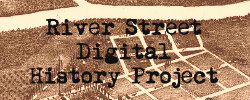Lee Rice, II
Growing up in River Street during the 1960s and 1970s, Lee Rice, II recalls River Street as a diverse community. Interpersonal relationships were based on familiarity rather than race and even people from outside the neighborhood were welcome.
“Even my friends from school would come over and hang out at the house, come over to the neighborhood…In high school when everything else was closed down there was always something happening. There was always some sort of house party.” (Rice 2014).
Everyone from the neighborhood had an understanding of what it was like to live in the neighborhood, but because there were so few blacks in Boise, most people from the town knew who the black kids were. Euroamericans in the rest of the city wanted African Americans to live in River Street, but, because they had years of contact with the neighborhood’s black people, the overt attempts at discrimination were lessened. Rice recalls some discrimination, but was not brought up that way. His family did not discriminate and based relationships based on an individual’s character. However, the negative identity of the neighborhood provided protection. Whites were reluctant to enter the neighborhood, so folks living South of the Tracks were safe in the neighborhood.
Rice recalls what happened to African Americans that decided to move outside of River Street. The Buckner family was among the first blacks to move from River Street to another part of town—the now historic North End district. African Americans in Boise recall that, in an attempt to scare the Buckner family back into the neighborhood, white Boiseans burned a cross in their front yard. The tactic did not work and members of the Buckner family still live in the North End. Rice recalls that the cross burning was an eye-opening event for River Street’s black community. Many of them were shocked to hear that such a thing happened, but the event proved the lengths Euroamericans in Boise would go in order to maintain segregation.
Kids from River Street used to play along the river. Rice recalls hanging onto a small rope bridge to cross the river and play on the other side:
“We used to swim across the river to go to the park…Just at the Americana Bridge…you would cross there. And these rocks, they were jagged, the water’s rushing and they had this wire. And we would navigate across that and it was no problem…Sometimes we might slip and fall but it wasn’t anything major. ” (Rice 2014).
He laments the fact that, today, children are not given this opportunity. Rice stated that if the same thing were to happen today, the police would most likely get involved and stop the whole thing. In the past, that was simply how children played.
River Street children were like millions of other young Americans. They had chores such as watering the yard and tending to the garden. Kids in the neighborhood played ball in the street. Hours of fun were had at the gravel pit that occupied a portion of a currently paved parking lot. The Boise River was also a favorite playing area and lagoons that existed before the Greenbelt was created were attractions for the neighborhood children.
Lee Rice has big plans for the neighborhood. He has long hoped for River Street to have additional commercial venues to be added and foresees several other development projects in the area. Rice would like to see existing commercial buildings house businesses that would serve the community and for vacant lots to be developed into housing or additional commercial venues. He has not given up hope on his former home.
Most importantly, Rice wants the world to know that River Street was much more than “the Black Neighborhood”. It was a place where familiarity and community were the rule. People in the neighborhood got along and overlooked race lines in order to forge a community where kids could play safely and grow into productive adults.
Mr. Rice was extremely generous and provided several historical photos related to his family’s tenure in the River Street Neighborhood.
All of the oral history interviews recorded in 2014 for this website will be transcribed. Copies of the transcriptions will be housed at the Idaho State Historical Society Archives in Boise.
We would love to hear from you. Please Contact Us if you have any questions or comments.





